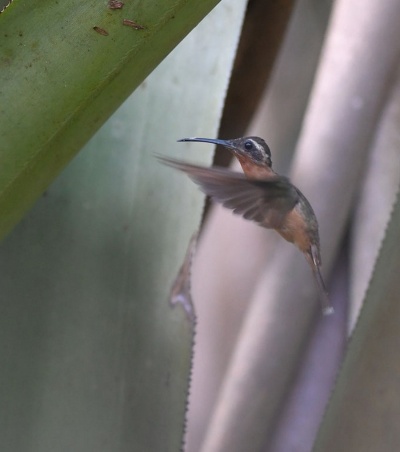(First image added. Dictionary link) |
(Basic tidy-up. Some extra info. Links. References) |
||
| Line 2: | Line 2: | ||
;[[: Category:Glaucis|Glaucis]] dohrnii | ;[[: Category:Glaucis|Glaucis]] dohrnii | ||
==Identification== | ==Identification== | ||
| − | + | 12–13 cm (4¾-5¼ in) | |
| − | + | *Greenish-bronze upperparts | |
| + | *Cinnamon underparts | ||
| + | *White [[Topography#Heads|supercilium]] and [[Topography#Heads|malar]] | ||
| + | *Metallic bronze tail with outer [[Topography#Tails|rectrices]] tipped white | ||
| + | *Bill almost straight whitish mandible. | ||
| + | ====Similar Species==== | ||
| + | Similar to [[Rufous-breasted Hermit]] | ||
==Distribution== | ==Distribution== | ||
| − | South | + | [[South America]]: found in coastal south-eastern [[Brazil]] (Bahia and Espírito Santo). |
==Taxonomy== | ==Taxonomy== | ||
This is a [[Dictionary_M-S#M|monotypic]] species<sup>[[#References|[1]]]</sup>, which in the past has been placed in genus ''[[: Category:Ramphodon|Ramphodon]]''. | This is a [[Dictionary_M-S#M|monotypic]] species<sup>[[#References|[1]]]</sup>, which in the past has been placed in genus ''[[: Category:Ramphodon|Ramphodon]]''. | ||
==Habitat== | ==Habitat== | ||
| − | + | Found in the understorey of damp lowland primary and littoral forests. Generally under 500m. | |
==Behaviour== | ==Behaviour== | ||
| − | + | ====Diet==== | |
| − | + | Their main diet consists of nectar and arthropods. They feed by the [[Dictionary_T-Z#T|trap-lining]] method. | |
| + | ====Breeding==== | ||
| + | They are reported to breed from September to February. | ||
| + | ==References== | ||
| + | #{{Ref-Clements6thAug18}}#Handbook of the Birds of the World Alive (retrieved February 2019) | ||
| + | {{ref}} | ||
==External Links== | ==External Links== | ||
{{GSearch|Glaucis+dohrnii}} | {{GSearch|Glaucis+dohrnii}} | ||
[[Category:Birds]][[Category:Glaucis]] | [[Category:Birds]][[Category:Glaucis]] | ||
Latest revision as of 22:29, 8 February 2019
- Glaucis dohrnii
Identification
12–13 cm (4¾-5¼ in)
- Greenish-bronze upperparts
- Cinnamon underparts
- White supercilium and malar
- Metallic bronze tail with outer rectrices tipped white
- Bill almost straight whitish mandible.
Similar Species
Similar to Rufous-breasted Hermit
Distribution
South America: found in coastal south-eastern Brazil (Bahia and Espírito Santo).
Taxonomy
This is a monotypic species[1], which in the past has been placed in genus Ramphodon.
Habitat
Found in the understorey of damp lowland primary and littoral forests. Generally under 500m.
Behaviour
Diet
Their main diet consists of nectar and arthropods. They feed by the trap-lining method.
Breeding
They are reported to breed from September to February.
References
- Clements, J. F., T. S. Schulenberg, M. J. Iliff, D. Roberson, T. A. Fredericks, B. L. Sullivan, and C. L. Wood. 2018. The eBird/Clements checklist of birds of the world: v2018. Downloaded from http://www.birds.cornell.edu/clementschecklist/download/
- Handbook of the Birds of the World Alive (retrieved February 2019)
Recommended Citation
- BirdForum Opus contributors. (2024) Hook-billed Hermit. In: BirdForum, the forum for wild birds and birding. Retrieved 7 May 2024 from https://www.birdforum.net/opus/Hook-billed_Hermit




